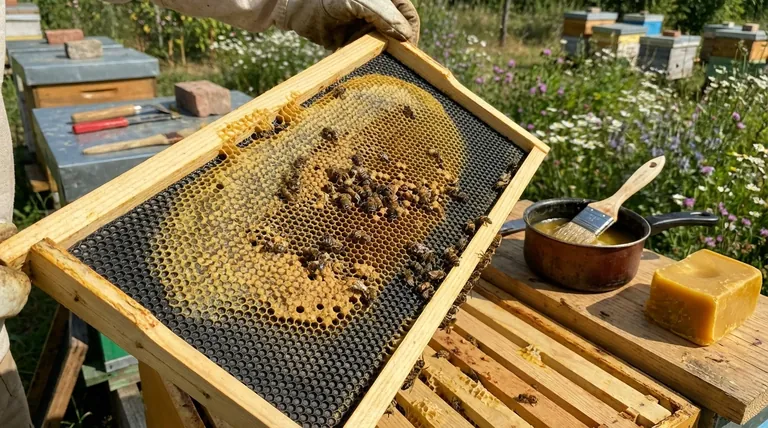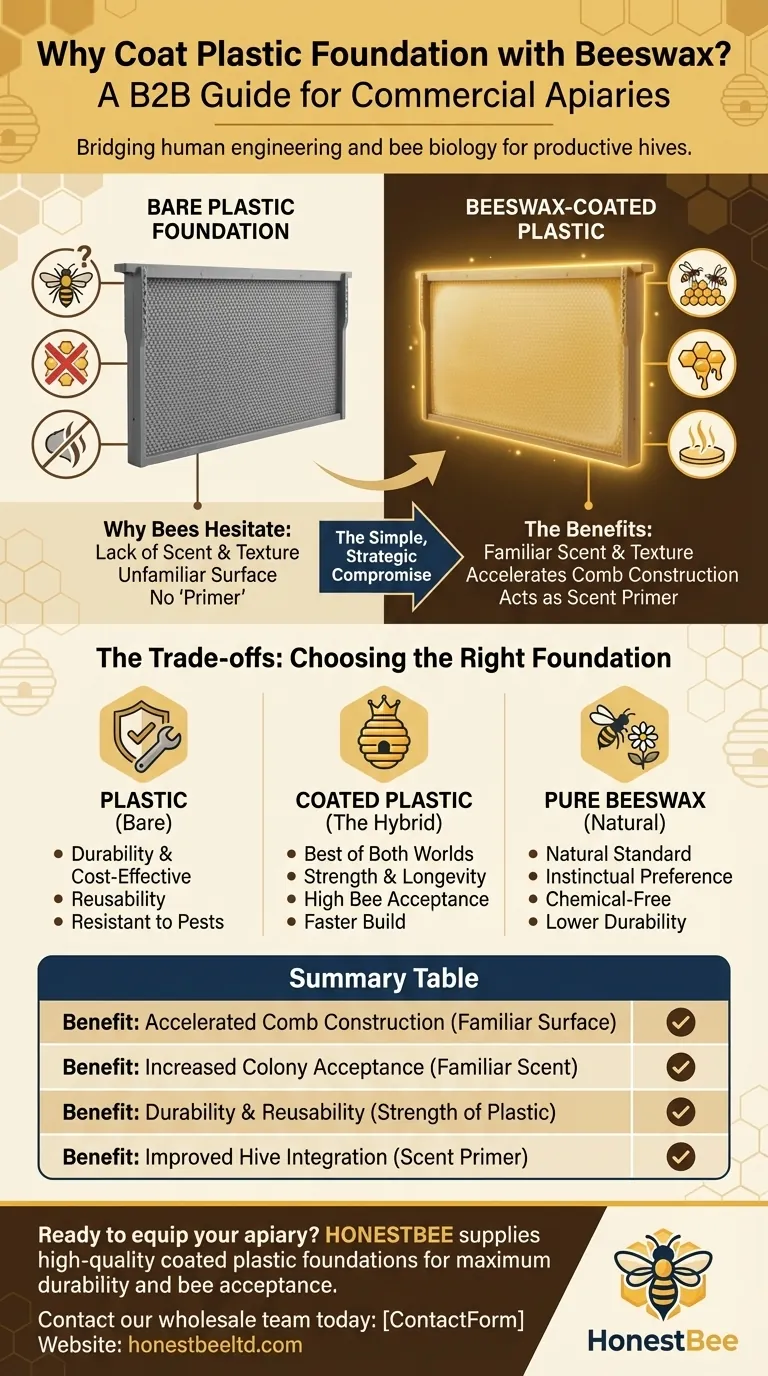Fundamentally, coating plastic foundation is about bridging a gap between human engineering and bee biology. You are applying a thin layer of natural beeswax to an artificial plastic base to make it more appealing to the bees. This simple step dramatically increases the likelihood that the colony will accept the foundation and begin the critical work of drawing out comb, which is essential for brood-rearing and honey storage.
Beekeepers face a choice between the durability of plastic foundation and the natural appeal of pure beeswax. Coating plastic with wax isn't just a minor improvement; it's a strategic compromise that combines the structural integrity and longevity of plastic with the familiar scent and texture that bees instinctually require to build their home.

Why Bees Hesitate with Uncoated Plastic
To understand the benefit of coating, we must first appreciate why bees often reject bare plastic. Bees operate on instinct, and a slick, odorless sheet of plastic offers none of the cues they are evolved to recognize.
The Critical Role of Scent and Texture
Bees have an innate affinity for beeswax. It is the material they naturally produce and work with.
A pure beeswax foundation has a familiar scent and a workable texture that immediately signals "home" and "build here" to a worker bee. Uncoated plastic lacks both of these essential properties.
An Unfamiliar Building Surface
The surface of bare plastic can be jarring and foreign to bees. It doesn't provide the same purchase for their feet or the right starting texture to begin secreting and shaping their own wax.
This hesitation can lead to a significant delay in comb building, slowing the colony's growth and productivity.
The Need for a Scent "Primer"
Bees communicate and orient themselves using pheromones. A layer of beeswax acts as a primer, capable of absorbing and holding the colony's unique scent.
This scent marking helps integrate the frame into the hive, making it part of the collective colony rather than a foreign object to be ignored.
The Key Benefits of a Beeswax Coat
Applying even a thin layer of beeswax directly counteracts the shortcomings of bare plastic, transforming it into a highly effective tool for the beekeeper.
Accelerating Comb Construction
The wax coat provides a familiar and ready-made surface for bees to work. They can immediately begin drawing out the cells instead of hesitating or ignoring the frame.
Some beekeepers apply an extra heavy coat of beeswax specifically to encourage the fastest possible comb construction, which is especially useful during a strong nectar flow.
Increasing Colony Acceptance
Frames coated in beeswax are accepted and utilized by the colony much faster than bare plastic.
This rapid acceptance means the queen can begin laying eggs sooner and workers can start storing honey and pollen more quickly, leading to a stronger, more robust hive.
Improving Hive Insulation
While a secondary benefit, the addition of beeswax to the frames adds to the overall thermal mass within the hive.
This contributes, albeit slightly, to better insulation and temperature regulation for the colony.
Understanding the Trade-offs: Plastic vs. Pure Beeswax
The decision to use coated plastic is rooted in a clear set of trade-offs. Neither plastic nor pure beeswax is perfect; the best choice depends on your goals.
The Case for Plastic: Durability and Cost
Plastic foundation is exceptionally durable. It does not sag or warp in high heat and is highly resistant to damage from wax moths or mice in storage.
Because it can be scraped clean and reused for many years, it is often the more cost-effective option in the long run.
The Case for Pure Beeswax: The Natural Standard
Pure beeswax foundation is the most natural option. Bees have an instinctual preference for it, and it contains none of the potential chemical additives that may be present in some plastics.
Many beekeepers pursuing a more natural or treatment-free philosophy prefer to use only pure beeswax, especially if it's sourced from their own disease-free hives.
The Compromise: Coated Plastic
Coated plastic foundation offers a "best of both worlds" solution. You gain the strength, reusability, and pest resistance of plastic while providing the natural incentive bees need to get to work.
Making the Right Choice for Your Apiary
Your decision on foundation type should be guided by your specific goals for cost, labor, and beekeeping philosophy.
- If your primary focus is rapid expansion and long-term cost savings: Coated plastic foundation is the superior choice for its durability and reusability.
- If your primary focus is a completely natural hive environment: Pure beeswax foundation, especially from your own hives, best aligns with this philosophy.
- If your primary focus is maximizing bee acceptance on new equipment: Applying an extra heavy coat of beeswax to your plastic foundation can significantly accelerate the process.
By understanding the fundamental motivations of your bees, you can equip your hive for maximum health and productivity.
Summary Table:
| Benefit | Key Advantage |
|---|---|
| Accelerated Comb Construction | Provides a familiar surface for bees to start building immediately. |
| Increased Colony Acceptance | Familiar scent and texture reduce hesitation and rejection. |
| Durability & Reusability | Combines the strength of plastic with the appeal of beeswax. |
| Improved Hive Integration | Wax coat acts as a scent primer, helping frames integrate into the colony. |
Ready to equip your apiary with foundations your bees will love?
At HONESTBEE, we supply high-quality beekeeping supplies and equipment to commercial apiaries and distributors. Our coated plastic foundations are designed for maximum durability and bee acceptance, helping you build stronger, more productive hives.
Contact our wholesale team today to discuss your needs and discover how our products can support your beekeeping success.
Visual Guide

Related Products
- Food Grade Plastic bee Foundation for Bee Frames
- Beeswax Foundation Sheets Beehive Foundation for Wholesale
- Notebook Style Beeswax Foundation Mould Wax Foundation Mold
- Manual Beeswax Comb Foundation Machine Wax Foundation Mill Embossing Machine
- Colorful Silicone Beeswax Foundation Mold Mould for Beekeeping
People Also Ask
- How do you get bees to draw out plastic foundation? Master the Art of Comb Building
- What is a plastic foundation sheet? A Durable, Reusable Hive Management Solution
- How to get bees to use plastic foundation? Master the Wax Coating and Resource Strategy
- What additional step can improve the performance of plastic foundation in the hive? Apply a Generous Coat of Beeswax
- How to get bees to draw out plastic foundation? Boost Comb Building with Proven Tactics



















